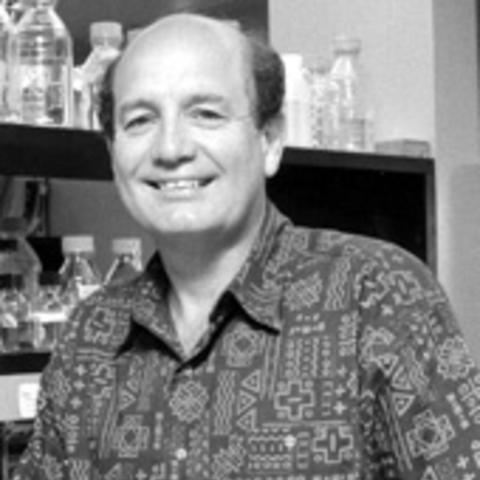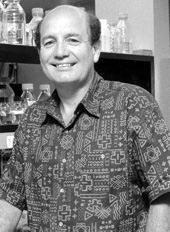Department of Microbiology and Immunology Faculty

Research Summary
Ecology, biochemistry and genetics of methylotropic bacteria
Some bacteria that grow on methanol synthesize methanol dehydrogenase as 20% of the total cellular protein. This enzyme contains a large and small subunit. The structural genes for these subunits, for a chaperone and proteins required to attach the prosthetic group and incorporate calcium into the active site of the enzyme, are linked on the genome. Eight positively-acting regulatory proteins have been identified that are uniquely required for transcription of the genes in this regulon. Four are required for methanol dehyrogenase expression only and four others are required for expression of MDH as well as several other methanol inducible regulons. We are attempting to purify the regulatory proteins and identify their interactions and binding sites on DNA segments upstream of the MDH regulon.
We also study the ecology of very diverse bacteria that oxidize methane. We use phylogenetic signature probes and gene probes that encode unique enzymes in methane-oxidizing bacteria to detect these bacteria in complex communities of bacteria from natural habitats. We also use newly developed techniques to isolate new methane-oxidizing bacteria. These techniques include opposing gradients of gases and other chemicals that allow us to separate and grow different methanotrophs in agarose columns.
Publications
- Jahng D. , C.S. Kim, R.S. Hanson, and T.K. Wood. (1996) Optimization of trichloroethylene degredation using solumble methane monooxygenase of Methylosinus trichosporium OB3b expressed in recombinant bacteria. Biotechnology and Bioengineering 51:349-359.
- Hanson R.S. , and T.E. Hanson. (1996) Methanotrophic Bacteria. Microbiological Reviews 439-471.
- Xu, H., J. Janka, M. Viebahn, and R.S. Hanson. (1995) Nucleotide sequence of the mxcQ and mxcE genes required for methanol dehydrogenase synthese in Methylobacterium organophilum XX: A two-component regulatory system. Microbiology 141:2543-2251.
- Brusseau, G.A., E.S. Boulygina, and R.S. Hanson. (1994) Phylogenetic analysis and development of probes for differentiating methylotrophic bacteria. Appl. Environ. Microbiol. 60:626-636.


Bio
Expertise
Bacteriophage phi29 structure and assembly
Research Summary
Structure and Assembly of Bacteriophage ø29 Bacteriophage ø29 of Bacillus subtilis offers the opportunity for a complete understanding of the structure and assembly of a complex dsDNA bacterial virus in molecular terms. Current goals include uncovering the mechanisms of a) assembly of the viral precursor capsid (prohead) in vitro from purified proteins and a host chaperonin, b) assembly and function of the powerful motor that packages the dsDNA and the mechanochemical energy transduction, c) sequential protein and DNA conformational changes that regulate assembly, and d) tail penetration of the cell wall during infection. Atomic resolution structures of five of eight ø29 structural proteins have been produced, and a complete atomic resolution structure of the virus is within reach. A sequence of single-particle, asymmetric cryoEM-3D reconstructions of mature and empty virions have been produced in collaborations. A sub-nanometer reconstruction has revealed protein secondary structural elements in situ, rearrangement of connector alpha helices, remodeling of the shell protein where it contacts DNA, and a 60Å diameter DNA toroid in the junction between connector/lower collar that may form as the DNA responds to linear compression. The mechanochemical cycle of the packaging motor has been probed by the use of laser tweezers single molecule studies in collaboration. Phosphate or ADP release is likely the power stroke of the motor. Use of optical tweezers capable of 1 bp resolution has revealed a highly coordinated motor in which the gp16 ATPase subunits load with ATP during a “dwell”, followed by rapid firings of the subunits to package 10 bp of DNA in a “burst” which consists, surprisingly, of four 2.5-bp steps. Load bearing contacts with phosphates that regulate the chemical cycle take place during the dwell phase every 10-bp on the 5’-3’ strand in the direction of packaging. Strong phosphate contacts hold the DNA in place during the dwell phase, while less specific contacts drive translocation during the burst phase. The ø29 tail proteins gp13 and gp12* have enzymatic activities, forecasting an understanding of tail penetration of the cell wall in infection. The morphogenetic factor gp13, located at the distal tip of the tail knob, is a Zn2+-D,D-endopeptidase that cleaves the peptide cross-link of the B. subtilis cell wall. Its structure was solved to 1.8Å resolution by X-ray crystallography. An autocatalytic assembly mechanism of the gp12 tail appendages was demonstrated by X-ray crystallography. The gp12 C-terminal domain is an “auto-chaperone” that aids trimerization, and auto-cleavage of the domain is followed by a unique ATP-dependent release. Subsequently, three domains of the N-terminus function in appendage attachment, cell wall digestion, and host binding, respectively.
Publications
- Ding, F., C. Lu, W. Zhao, R. R. Kanagalaghatta, D. L. Anderson, P. J. Jardine, S. Grimes, and A. Ke. 2011. Structure and assembly of the essential RNA ring component of a viral DNA packaging motor. Proc. Natl. Acad. Sci. U.S.A.108:7357-7362.
- Aathavan, K., A. T. Politzer, A. Kaplan, J. R. Moffitt, Y. R. Chemla, S. Grimes, P. J. Jardine, D. L. Anderson, and C. Bustamante. 2009. Substrate Interactions and Promiscuity in a Viral DNA Packaging Motor. Nature 461:669-673.
- Xiang, Y., P. G. Leiman, L. Li, S. Grimes, D. L. Anderson, and M. G. Rossmann. 2009. Crystallographic insights into the autocatalytic assembly mechanism of a bacteriophage tail spike. Mol. Cell 34:375-386. PMC Journal - In Process.
- Cohen, D. N., Y. Y. Sham, G. D. Haugstad, Y. Xiang, M. G. Rossmann, D. L. Anderson, and D. L. Popham. 2009. Shared catalysis in virus entry and bacterial cell wall depolymerization. J. Mol. Biol. 387:607-618. PMC Journal – In Process.
- Moffitt, J. R., Y. R. Chemla, K. Aathavan, S. Grimes, P. J. Jardine, D. L Anderson, and C. Bustamante. 2009. Intersubunit coordination in a homomeric ring ATPase. Nature 457:446-450. PMC Journal - In Process.
- Zhao, W., M. C. Morais, D. L. Anderson, P. J. Jardine, and S. Grimes. 2008. Role of the CCA bulge of prohead RNA of bacteriophage ø29 in DNA packaging. J. Mol. Biol. 383:520-528. PMC Journal - In Process.
- Koti, J. S., M. C. Morais, R. Rajagopal, B. A. L. Owen, C. T. McMurray, and D. L. Anderson. 2008. DNA packaging motor assembly intermediate of bacteriophage ø29. J. Mol. Biol. 381:1114-1132. PMC Journal – In Process.
- Xiang, Y., M. C. Morais, D. C. Cohen, V. D. Bowman, D. L. Anderson, and M. G. Rossmann. 2008. Crystal and cryoEM structural studies of a cell wall degrading enzyme in the bacteriophage ø29 tail. Proc. Natl. Acad. Sci. U.S.A. 105: 9552-9557. PMCID:PMC2474476.
- Morais, M. C., J. S. Koti, V. D. Bowman, E. Reyes-Aldrete, D. L. Anderson, and M. G. Rossmann. 2008. Defining molecular and domain boundaries in the bacteriophage ø29 DNA packaging motor. Structure. 16:1267-1274. PMC Journal – In Process.
- Kitamura, A., P. J. Jardine, D. L. Anderson, S. Grimes, and H. Matsuo. 2008. Analysis of intermolecular base pair formation of prohead RNA of the phage ø29 DNA packaging motor using NMR spectroscopy. Nucleic Acids Res. 36:839-848. PMCID: PMC2241910
- Cohen, D. N., S. E. Erickson, Y. Xiang, M. G. Rossmann, and D. L. Anderson. 2008. Multifunctional roles of a bacteriophage phi 29 morphogenetic factor in assembly and infection. J. Mol. Biol. 378: 804-817. PMCID: PMC2443984.
- Tang, J., N. Olson, P. J. Jardine, S. Grimes, D. L. Anderson, and T. S. Baker. 2008. DNA poised for release in bacteriophage ø29. Structure 6:935-943. PMCID: PMC2556148.
- Comolli, L. R., A. J. Spakowitz, C. E. Siegerist, P. J. Jardine, S. Grimes, D. L. Anderson, C. Bustamante, and K. H. Downing. 2008. Three-dimensional architecture of the bacteriophage ø29 packaged genome and elucidation of its packaging process. Virology 371:267-277.
- Rickgauer, J. P., D. N. Fuller, S. Grimes, P. J. Jardine, D. L. Anderson, and D. E. Smith. 2008. Portal motor velocity and internal force resisting viral DNA packaging in bacteriophage ø29. Biophys J. 94:159-167. PMCID: PMC2134861.
- Fuller, D. N., D. M. Raymer, J. P. Rickgauer, R. M. Robertson, C. E. Catalano, D. L. Anderson, S. Grimes, and D. E. Smith. 2007. Measurements of single DNA molecule packaging dynamics in phage lambda reveal high forces, high motor processivity, and capsid transformations. J. Mol. Biol. 373:1113-1122.
- Fuller, D., J. P. Rickgauer, P. J. Jardine, S. Grimes, D. L. Anderson, and D. E. Smith. 2007. Ionic effects on viral DNA packaging and portal motor function in bacteriophage ø29. Proc. Natl. Acad. Sci. U. S. A. 104:11245-11250. PMCID: PMC2040884.
- Atz, R., S. Ma, J. Gao, D. L. Anderson, and S. Grimes. 2007. Alanine scanning and Fe-BABE probing of the bacteriophage ø29 prohead RNA-connector interaction. J. Mol. Biol. 369:239-248. PMCID: PMC1976407
- Hugel, T., J. Michaelis, C. L. Hetherington, P. J. Jardine, S. Grimes, J. M. Walter, W. Falk, D. L. Anderson, and C. Bustamante. 2007. Experimental test of connector rotation during DNA packaging into bacteriophage ø29 capsids. PLoS Biol. 5:e59. PMCID: PMC1800307.
- Xiang, Y., M. C. Morais, A. J. Battisti, S. Grimes, P. J. Jardine, D. L. Anderson, and M. G. Rossmann. 2006. Structural changes of bacteriophage ø29 upon DNA packaging and release. EMBO J. 25:5229-5239. PMCID: PMC1630414.
- Jardine, P. J. and D. Anderson. 2006. DNA packaging in double-stranded DNA bacteriophages. In The Bacteriophages, R. Calendar, ed., Oxford Press, Chapter 6, 49-65.
- Choi, K. H., M. C. Morais, D. L. Anderson, and M. G. Rossmann. 2006. Determinants of bacteriophage ø29 head morphology. Structure 14:1723-1727.
- Morais, M. C., K. H. Choi, J. S. Koti, P. R. Chipman, D. L. Anderson, and M. G. Rossmann. 2005. Conservation of the capsid structure in tailed dsDNA bacteriophages: the pseudoatomic structure of ø29. Mol. Cell 18:149-159.
- Chemla, Y. R., K. Aathavan, J. Michaelis, S. Grimes, P. J. Jardine, D. L. Anderson, and C. Bustamante. 2005. Mechanism of force generation of a viral DNA packaging motor. Cell 122: 683-692.
- Anderson, D. and S. Grimes. 2005. The ø29 DNA packaging motor: seeking the mechanism. In Viral Genome Packaging. C. Catalano, ed., Landes Bioscience, Chapter 7.
Contact
Address
Institute for Molecular Virology18-242 Moos Tower 515 Delaware St SE
Minneapolis, MN 55455


Research Summary
The molecular basis for streptococci disease
Streptococci are masters of immune avoidance. S. pyogenes, the most common cause of sore throat, are also responsible for serious diseases such as rheumatic fever, heart disease, and flesh eating wound infections. My research investigates the molecular and cellular processes that lead to these infections. Current experiments aim to define the impact of surface proteins, C5a peptidase and M protein, on persistence of S. pyogenes in the host. These multifunctional proteins interact with extracellular matrix proteins and cellular receptors to target streptococci to immune tissues. Experiments attempt to define host cell signaling pathways that lead to intracellular invasion and whether infection of secondary lymphoid tissue alters the immune response to streptococci. Studies of the cellular immune response to infection are another focus, which could help understand why children fail to develop a protective immune response following infection. A collaboration with a major pharmaceutical company will soon test a C5a peptidase vaccine in humans for prevention Strep throat. Molecular genetic, immunochemical and sophisticated imaging methods are used in these studies
Publications
- Cleary, P. P. 2006. Streptococcus moves inward. Nat Med 12:384-6.
- Wang, B., S. Li, P. J. Southern, and P. P. Cleary. 2006. Streptococcal modulation of cellular invasion via TGF-beta1 signaling. Proc Natl Acad Sci U S A 103:2380-5.
- Brown, C. K., Z. Y. Gu, Y. V. Matsuka, S. S. Purushothaman, L. A. Winter, P. P. Cleary, S. B.Olmsted, D. H. Ohlendorf, and C. A. Earhart. 2005. Structure of the streptococcal cell wall C5a peptidase. Proc Natl Acad Sci U S A 102:18391-6.
- Park, H. S. and P. P. Cleary. 2005. Active and passive intranasal immunizations with streptococcal surface protein C5a peptidase prevent infection of murine nasal mucosa-associated lymphoid tissue, a functional homologue of human tonsils. Infect Immun 73:7878-86.
- Park, H. S., M. Costalonga, R. L. Reinhardt, P. E. Dombek, M. K. Jenkins, and P. P. Cleary. 2004. Primary induction of CD4 T cell responses in nasal associated lymphoid tissue during group A streptococcal infection. Eur J Immunol 34:2843-53.


Research Summary
My laboratory studies the regulation of expression of genetic transfer functions and the regulation of virulence in gram positive bacteria. We are especially interested in regulatory mechanisms involving cell-cell signaling by peptide mating pheromones. We also study several novel intracellular regulatory RNA molecules that control expression of genes involved in conjugative plasmid transfer. Additional projects in the lab are focused on functional genomics of enterococci, with special emphasis on biofilm formation, antibiotic resistance and virulence.Since the MICaB program began, I have trained 10 Ph students and 10 postdoctoral fellows.
Publications
- Barnes, Aaron MT, Ballering, Katie S., Leibman, Rachel S., Wells, Carol L., Dunny, Gary M. 2012. Enterococcus faecalis Produces Abundant Extracellular Structures Containing DNA in the Absence of Cell Lysis during Early Biofilm Formation. mBio 3(4):e00193-12. doi:10.1128/mBio.00193-12.
- Chatterjee, A., Cook, LCC, Shu, CC, Chen, Y, Manias DA, Ramkrishna, D., Dunny, GM, Hu, W-S .2013. Antagonistic self-sensing and mate-sensing signaling controls antibiotic-resistance transfer. PNAS, 110(17), 7086-7090.
- Frank KL, Guiton PS, Barnes AM, Manias DA, Chuang-Smith ON, Kohler PL, Spaulding AR, Hultgren SJ, Schlievert PM, Dunny GM. 2013. AhrC and Eep are biofilm infection-associated virulence factors in Enterococcus faecalis. Infect Immun. 2013 May;81(5):1696-708.
- Johnson CM, Haemig HH, Chatterjee A, Wei-Shou H, Weaver KE, Dunny GM. 2011. RNA-mediated reciprocal regulation between two bacterial operons is RNase III dependent. MBio.2(5). pii: e00189-11.
- Cook L, Chatterjee A, Barnes A, Yarwood J, Hu WS, Dunny G. 2011. Biofilm growth alters regulation of conjugation by a bacterial pheromone. Mol Microbiol. 2011 Sep;81(6):1499-510.
Contact
Address
4-117 MRF689 23rd Ave SE
Minneapolis, MN 55455


Research Summary
Tumor viruses, oncogenesis, gene transfer
My research group examined the mechanism(s) by which two groups of tumor viruses, retroviruses and papillomaviruses, replicate and transform cells. To this end, we used molecular biological approaches to increase our understanding of the structure and function of tumor virus genes and their specific products. My lab's studies led to the identification, in most vertebrate species, of novel endogenous retroviruses as well as genetic sequences present in normal cells that may represent evolutionary precursors to certain tumor virus genes. Continuing studies will elucidate the nature of these genes and their possible function in growth and development, as well as in oncogenesis. My laboratory also investigates the role tumor viruses play in the induction of benign tumors and their progression to the malignant phenotype, particularly in people with genetic predisposition. Another study in the laboratory uses gene transfer and gene expression technologies to produce transgenic fish that exhibit properties of enhanced growth and disease resistance. All of the work in my laboratory uses state-of-the-art molecular biological technologies, including recombinant DNA, hybridoma, and gene sequencing/synthesis procedures.
Publications
- Faras, A. J. (1995) Oncology from bench to bedside. Minnesota Physician 9 (3):16-18.
- Ostrow, R., S. Coughlin, R. McGlennen. N. Johnson, M. Ratterree, J. Scheffler, N. Yaegashi, G. Galloway, and A. Faras. (1995) Serological and molecular evidence of rhesus papillomavirus type 1 infections in tissues from geographically distinct institutions. J. Gen. Virol. 76:293-299.
- Li, M., D. Bronson, T. Lemke, and A. Faras. (1995) Restricted expression of new HERV-K members in human teratocarcinoma cells. Virology 208:733-741.


Research Summary
Antigen-Antibody Interactions; Apoptosis
My laboratory contributed to the seminal study showing that cytochrome c (Cyt c) translocates from mitochondria to the cytoplasm during apoptosis and plays a key role in the activation of programmed cell death (Cell 86:147-157, 1996). One monoclonal antibody specific for the native protein was used to remove Cyt c, thus showing that this protein and not a contaminant was responsible for the pro-apoptotic activity and another monoclonal antibody specific for the carboxyl terminal dodecapeptide was used to show Cyt c translocation to the cytoplasm by Western blotting. Later we found that Cyt c is released from apoptotic cells as an intact protein (Cell Death Differ. 9:538-548, 2002). Consequently, Cyt c has been explored as a potential clinical biomarker for aberrant apoptosis in vivo.
By distinguishing monoclonal antibodies that recognize native versus denatured Cyt c we also identified an antibody recognizing an altered conformation of Cyt c that has biological relevance (Biochemistry 36: 3599-3609, 1999). The altered form arises when the sixth ligand to the heme moiety is lost, endowing the protein with peroxidase activity and the ability to translocate to the nucleus without activating apoptosis (PNAS 119: e2213432119, 2022). This monoclonal antibody is, thus, a useful tool to examine a potential role of Cyt c in the nucleus, possibly affecting gene expression.
While developing an immunoassay to detect Cyt c in serum we discovered that leucine-rich alpha-2-glycoprotein-1 (LRG1) binds Cyt c and inhibits its detection in an antibody-based assay (Apoptosis 11:1121-1129, 2006). LRG1 has been implicated as a biomarker for a variety of cancers and microbial infections. However, its function was unknown. We have shown that LRG1 binds Cyt c in a manner similar to that of the protein Apaf-1 that initiates the intrinsic pathway of apoptosis. In vitro serum LRG1 acts as a survival protein extending the half -life of lymphocytes (Apoptosis 15:139-152, 2010). Recently, we demonstrated that, in MCF-7 breast cancer cells, cytoplasmic LRG1 competes with Apaf-1 for binding Cyt c in situ and, thus, inhibits the onset of apoptosis. We developed an enzyme-linked immunosorbent assay for LRG1 that may be useful clinically (J. Immunol. Methods 336:22-29, 2008).
Our apoptosis-related research evolved from studies of antibody recognition employing Cyt c as the model antigen. We made a number of observations that give insight into the antibody response with implications for vaccine development. We uncovered an artifact in immunoassays that misled researchers into believing that peptides could be broadly used as vaccines (PNAS 84:9180-9184, 1987). Even when a peptide can bind antibodies elicited against a native protein antigen this does not necessarily indicate that the peptide can activate B cells producing those antibodies as a certain affinity threshold must be met (Mol. Immunol. 26:301-307, 1989). We also showed that approximately 10% of memory B cells can be activated in an environment of T cell help in the absence of the cognate B cell antigen (Eur. J. Immunol. 21:951-958). This may explain, at least in part, the longevity of B cell memory after antigen has been depleted in vivo. We found that affinity maturation in the antibody response to a protein antigen follows the paradigm established for responses to smaller chemical compounds. Thus, an affinity increase of several hundred fold can result from DNA mutations at only a few key nucleotide positions in antibody genes (J. Immunol. 157:5329-5338, 1996). Much more about this phenomenon is explained in a follow-up review (Recent Res. Dev. Immunol. 4:13-25, 2002).
A surprising observation was a higher frequency of B lymphocytes in mice specific for mouse Cyt c than for foreign Cyts c (Eur. J. Immunol. 25:784-791, 1995). The autoreactive B cells generally expressed the same antibody heavy and light chain genes but were quite variable in CDR3 of the heavy chain. We speculate that mouse Cyt c may serve as a ligand for B cell positive selection. Supporting this idea, the antibody response to the closely related pigeon Cyt c actually initiates as a response more specific for mouse Cyt c utilizing those same variable region genes and eventually becomes more specific for pigeon Cyt c (PNAS 92:12379-12383, 1995).
Publications
- Jemmerson, R. (2024) Cytochrome c keeps on giving--A conformational change detected in situ with an antibody probe adds to the intricacies of its cellular functions. 21st Century Pathology 4(1):157-162.
- Tomasina, F., Martinez, J., ..., Jemmerson, R., Piacenza, L., and Radi, R. (2022) De novo sequencing and construction of a unique antibody for the recognition of alternative conformations of cytochrome c in cells.Proc. Natl. Acad. Sci. U.S.A. 119: e2213432119
- Jemmerson, R. (2023) LRG1, a blood and intracellular glycoprotein, interacts with cytochrome c to promote cell survival and block inflammation. 21st Century Pathology 3: 147.
- Jemmerson, R. (2021) Paradoxical roles of leucine-rich alpha 2-glycoprotein-1 in cell death and survival modulated by transforming growth factor-beta1 and cytochrome c. Front. Cell Dev. Biol. doi: 10.3389/fcell.2021.744908
- Jemmerson, R., Staskus, K., Higgins, L., Conklin, K., and Kelekar, A. 2021. Intracellular leucine-rich alpha-2-glycoprotein-1 competes with Apaf-1 for binding cytochrome c in protecting MCF-7 breast cancer cells from apoptosis. Apoptosis 26:71-82.
- Hannibal, L., Tomasina, F., Capdevila, D.A., Demicheli, V., Tortora, V., Alvarez-Paggi, D., Jemmerson, R., Murgida, D.H., and Radi, R. 2016. Alternative conformations of cytochrome c: Structure, function, and detection. Biochemistry 55:407-428.
- Lowman, X.H., McDonnell, M.A., Kosloske, A., Odumade, O.A., Jenness, C.B.,Jemmerson, R., and Kelekar, A. 2010. The proapoptotic Function of Noxa in human leukemia cells is regulated by the kinase Cdk5 and by glucose.Molecular Cell. 40:823-833.
- Codina, R., Vanasse, A. Kelekar, A., Vezys, V., andJemmerson, R.2010. Cytochromec-induced lymphotyte death from the outside in: Inhibition by serum leucine-rich alpha-2-glycoprotein-1. Apoptosis 15: 139-152.
- Cummings, C., Walder, J., Treeful, A., andJemmerson, R.2006. Serum leucine-rich alpha-2-glycoprotein-1 binds cytochromecand inhibits antibody detection of this apoptotic marker in enzyme-linked immunosorbent assay.Apoptosis 11:1121-1129.
- Jemmerson, R., Dubinsky, J. M., and Brustovetsky, N. 2005. Cytochrome c release from CNS mitochondria and potential for clinical intervention in apoptosis-mediated CNS diseases. Antioxid. Redox Signal. 7:1158-1172.
- Brustovetsky, N., Dubinsky, J. M., Antonsson, B., andJemmerson, R.2003. Two pathways for tBID-induced cytochromecrelease from rat brain mitochondria: BAK- versus BAX-dependence. J. Neurochem. 84:196-207.
- Jemmerson, R., LaPlante, B., and Treeful, A. 2002. Release of intact, monomeric cytochromec from apoptotic and necrotic cells.Cell Death and Differentiation 9:538-548.
- Jemmerson, R.2002.The molecular basis for affinity maturation in the antibody response to a protein antigen, cytochromec.Recent. Res. Devel. Immunology 4:13-25.
- Liu, X., Kim, C.N.,Jemmerson, R., Wang, X. 1996. Induction of apoptotic program in cell-free extracts: Requirement for dATP and Cytochromec.Cell 86:147-157.
- Mueller, C.M.,Jemmerson, R.1996. Maturation of the antibody response to the major epitope on the self antigen mouse cytochromec.J. Immunol 157:5329-5338.
- Minnerath, J.M., Mueller, C.M., Buron, S., and Jemmerson, R. 1995. B lymphocyte recognition of cytochrome c: Higher frequency of cells specific for self vs. foreign antigen early in the response and V gene usage in response to self antigen. Eur. J. Immunol. 25:784-791.
- Minerath, J.M., Wakem, L.P., Comfort, L.L., Sherman, F., and Jemmerson, R. (1995) The BALB/c mouse B cell response to pigeon cytochrome c initiates as a heteroclitic response specific for the self antigen mouse cytochrome c. Proc. Natl. Acad. Sci. U.S.A. 92:12379-12383.
- Jemmerson R. and Blankenfeld, R. 1989. Affinity consideration in the design of synthetic vaccines intended to elicit antibodies. Mol. Immunol. 26:301-307.
- Johnson, J.G. and Jemmerson, R. 1991. Relative frequencies of secondary B cells activated by cognate versus other mechanisms. Eur. J. Immunol. 21:951-958.
- Jemmerson, R.1987. Antigenicity and native structure of globular proteins: Low frequency of peptide reactive antibodies.Proc. Natl. Acad. Sci. USA. 84:9180-9184.
- Jemmerson, R.and Paterson, Y. 1986. Mapping epitopes on protein antigens by the proteolysis of antigen-antibody complexes.Science 232:1001-1004.


Research Summary
Molecular pathogenesis; Lyme disease and human granulocytic ehrlichiosis
I studied Borrelia burgdorferi, the etiologic agent of Lyme disease and the agent of human granulocytic ehrlichiosis. Most recent projects in the lab included the study of the ecology of Lyme disease, human granulocytic ehrlichiosis, in Minnesota.
Publications
- Ravyn, M.D., J.L. Goodman, C.B. Kodner, D.K. Westad, L.A. Coleman, S.M. Engstron, C.N. Nelson, and R.C. Johnson. (1998) Immunodiagnosis of human granulocytic ehrlichiosis using culture derived human isolates. J. Clin. Microbiol. 36:1480-1488
- Ravyn, M.D., L. Lamb, R. Jemmerson, J.L. Goodman, and R.C. Johnson. (1999) Characterization of monoclonal antibodies to an immunodominant protein of the etiologic agent of human granulocytic ehrlichiosis. Amer. J. Trop. Med. Hyg. 61:171-176


Research Summary
Molecular microbiology and ecology
Research efforts in my laboratory are directed toward the identification and examination of bacterial genes involved in the early periods of legume-microbe symbioses. We specifically are interested in studying Rhizobium and Bradyrhizobium genes that play a prominent role in host/microbe recognition and in the establishment of symbiotic, nitrogen-fixing nodules specific B. japonicum strains. In addition, my laboratory (in collaboration with Dr. Larry Wackett) is using recombinant DNA methodologies to construct novel biodegradation pathways that will allow recombinant bacteria to aerobically degrade recalcitrant, halogenated, environmental pollutants. We also are actively involved in defining bacterial biodegradation pathways for the herbicide atrazine and using isolated proteins and constructed bacteria to bioremediate atrazine-contaminated soils and water.
Publications
- Ishii S, Yan T, Shively DA, Byappanahalli MN, Whitman RL, Sadowsky MJ. 2006. Cladophora (Chlorophyta) spp. harbor human bacterial pathogens in nearshore water of Lake Michigan. Appl Environ Microbiol. 72(7):4545-53.
- Hamilton MJ, Yan T, Sadowsky MJ. 2006. Development of goose- and duck-specific DNA markers to determine sources of Escherichia coli in waterways. Appl Environ Microbiol. 72(6):4012-9.
- Regitano JB, Koskinen WC, Sadowsky MJ. 2006. Influence of soil aging on sorption and bioavailability of simazine. J Agric Food Chem. 54(4):1373-9.
- Ishii S, Ksoll WB, Hicks RE, Sadowsky MJ. 2006. Presence and growth of naturalized Escherichia coli in temperate soils from Lake Superior watersheds.Appl Environ Microbiol. 72(1):612-21.
- Accinelli C, Koskinen WC, Sadowsky MJ. 2006. Influence of Cry1Ac toxin on mineralization and bioavailability of glyphosate in soil. J Agric Food Chem. 54(1):164-9.
- Barriuso E, Koskinen WC, Sadowsky MJ. 2004. Solvent extraction characterization of bioavailability of atrazine residues in soils. J Agric Food Chem. 52(21):6552-6.